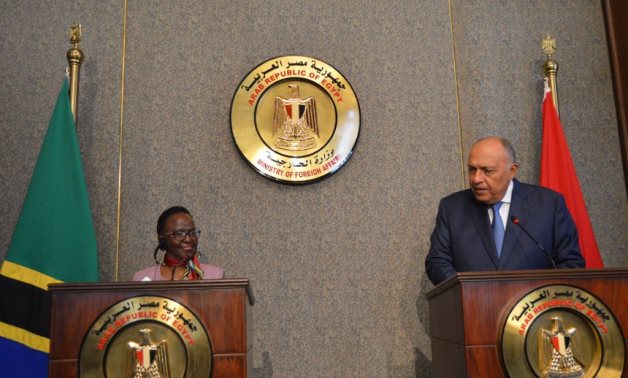
Egyptian foreign Minister Sameh Shoury in a joint press conference with his Tanzanian counterpart Liberata Mulamula, on Thursday- press photo.
CAIRO – 9 June 2022: "Tanzania is aware of Egypt’s concerns about the controversial Grand Ethiopian Renaissance Dam (GERD)," said Egyptian Foreign Minister Sameh Shoukry in a joint press conference with his Tanzanian counterpart Liberata Mulamula, on Thursday.
He added that coordination will be taking place between Egypt and Tanzania during the coming period, stressing the joint cooperation between the two countries in a number of different fields.
Mulamula stated that Tanzania is looking forward to cooperating with Egypt in the fields of information technology and irrigation technologies. “We look forward to strengthening cooperation between Egypt and Tanzania during the coming period, and we invite Egyptian companies to participate in our international exhibition.”
The Tanzanian foreign minister further clarified that Climate change-related issues in the African countries were discussed, noting that cooperation to determine the outcomes of the upcoming COP27 conference is vital to translate the recommendations into tangible results on the ground.
"Saving the generations to come from climate change is a must.. All countries are affected and actions must be taken quickly to address the climate change crisis,” Mulamula reiterated.
The dispute among Egypt, Sudan, and Ethiopia dates back to May 2011 when Ethiopia started building the dam; Egypt voiced concern over its water share [55.5 billion cubic meters].
Constructions in the Grand Renaissance Dam started on April 2, 2011 at a cost of $4.8 billion. It was built by the Italian construction and engineering company Salini Impergilo. The dam is located on the Blue Nile with a planned capacity of 74 billion cubic meters, and was expected to generate up to 6,000 megawatts of power.
However, it is estimated to generate only 3,000 megawatts, as the number of turbines to be installed has been reduced to 13 turbines down from 16.
The first and second fillings were carried out in 2020 and 2021, respectively, making the total 8 billion cubic meters.
Comments
Leave a Comment